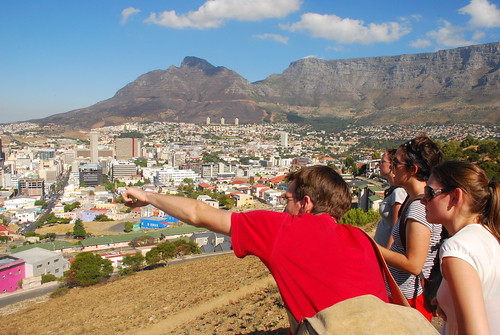p>I had begun to throw the concept of "Environmental Justice" around in a few classes I had taken in the past year, bouncing the idea around like a pinball around in my head, sounding out the phrase and teasing out its implications. I thought about it in a handful of contexts, most often in my class with Chris Wells, US Urban Environmental History, although it had been difficult for me to have any emotional attachment to the subject until I wrote a paper about the demolition of a black neighborhood in Saint Paul, Minnesota for the creation of a highway. Biking over Interstate 94 on my way to the Minnesota Historical Society to scourge for sources, the stark reality of a giant corridor dug out of the earth where a particularly poor, black neighborhood once stood became the image I carried with me to understand how the ability to shape, manipulate, extract and use "nature" is not evenly distributed through a society, and that discussions about environmentalism desperately need to be paired with discussions about political agency, social justice, and even racial inequalities. Landscapes, both urban and rural, are inherently laced with clues about which set of priorities and notions of little-e environmental philosophy are held by whichever set of power-brokers are in charge. It takes little work to notice that the distribution of natural resources across urban landscapes is hardly equal; access to recreational nature (beaches/parks), consumptive nature (food), resourceful nature (mining, energy production), and even Muiresque "preserved" nature (wildlife parks, reserves) are often controlled by particular groups of people in a society, and many others in society have to find their own navigation through these systemic inequalities to get access to the "nature" necessary for a sustainably lifestyle.
With this pretext, Cape Town is the most spectacular place in the world to study Environmental Justice. After spending the past few days muddling through clouds and dreary overcast skies in Curitiba and Buenos Aires, our subsequent few weeks in Cape Town reveal a pretty stark, blunt, monumental physical, urban, and social landscape. There are mountains, oceans, tons of open sky, exotic unique plants like fynbos, white people, black people, neither white-nor-black-but-still-maligned people, wealthy people, poor people, unmitigated pollution, virtually worthless systems of garbage collection and no ethos of recycling whatsoever, contests of modernity versus traditionalism, contests about the way the environment should be used between local, regional and global actors, influences on the landscape from places thousands of miles away. The story of Cape Town is just waiting for an astute reinterpretation of a city that has managed (and been managed by) world resources, people, and ideas for hundreds of years. The social and built landscapes of Cape Town are direct creations of an overarching society that likes to create dichotomies and social constructions about everything: urban/rural, urban/natural, black/coloured/white, wealthy/poor. Environmental Justice is not just a question of why black people in Langa don't have access to nice parks or suitable open spaces, but rather a pursuit to understand how a group of people managed to find different ways to differentiate and understand nature and people; rather, exactly who are black people anyway (and who decided that they are black?), and which ways are different subgroups of a population exposed to different sets of resources and experiences? It isn't enough to sit back and exclaim, "well, golly, the unsanitary garbage heaped in Langa's streets and the rat poison that is killing children in Khayelitsha sure is different and unequal from the way that Table Mountain and Cape Point have been canonized as sacred natural sites!" There are sets of political actors who are managing landscapes in this way; nothing is inevitable in the stories of cities.
This is to say that a certain set of political actors decided everything from which pieces of land (and subsequently which flora and fauna in the ecohotspot that is Cape Point, the world's smallest floral kingdom) would be preserved from significant human development, which people would be placed on which lands (and subsequently, how each group of people would have agency to affect/control their own plot), and how the resources in these different spatial locations will move about the city/metropole/region/country/continent/planet. I hate to make the comparison between "invasive species" and the racial subcategories of non-indigenous people residing in Cape Town because of the negative connotations implied by saying that certain people "don't belong," but the comparison is helpful, I think, in understanding that Cape Town has been created through so many contestations between subjects and objects originating both locally in the Western Cape and from far away colonizers in Britain and Holland and farther away colonized south east Asia. The skyscrapers, the style of the parks, the roads, the diets, the plants and animals, the racial constructions, so many tangible and intangible forces that constitute Cape Town exist thanks to a compromise between so many ideologies. I do find it helpful to think of Cape Town as a melting pot of so many different organisms that are fighting survival and for David Harvey's infamous Right to the City. Cape Town is a location on a historical trade route that has moved so many different people, plants, and animals onto the peninsula from so many different places around the world, be it commodities or people (or in the case of slaves, both) of British, Dutch, Indonesian, Malaysian, descent. Not all ideologies are weighted equal, of course; District Six as a delineated space within the city is currently the blank field that it is due to the historical shifting power balances and the different ways different ruling elites have tried to reshape the area for their interests, and the obvious historical ramifications of Apartheid have strongly shaped which people live in which areas and access which resources.
Some plants came to Cape Town and successfully took over the countryside (often with human help) both for human consumption and because they proved much more adaptable than the natural species of fynbos that originally grew.
<
Perhaps the most rewarding part about studying Environmental Justice is to find the interventions against this form of spatial and resource-based inequality. Whether visiting the Edith Stevens park, a bastion of ecological protection in the heart of Cape Flats, or visiting the Sustainability Institute that found ways to compost their own shit, or listening to Lance von Sittert's presentation on the way Table Mountain is being reinterpreted through the stories and uses of black African history to give the mountain to all of the city's inhabitants, its heartening to remember that these environmental injustices never happen without a fight; there's always concerned people out there, attempting to stage their own event to counter these systemic inequalities. Instead of seeing the Mountain from the water as the perfect backdrop to the perfect, "nonAfrican" African city (as problematic as that is), I grew to really like the view of Table Mountain from Langa. Sure, the view from the east townships destroys the notion that the Mountain is perfectly, picturesquely flat, and the mountain is less image-worthy when the view is obscured by the power plant, underlying slums, and the like (especially considering you can't even see the mountain at night since we weren't allowed to go out at night in the first place), but then again, this is the way that the majority of Cape Town's citizens figuratively and literally see the mountain, and thus, it reflects a fascinating, sordid truth about life in the Mother City. You won't hear this story next year, when Cape Town hosts the 2010 World Cup; after all, urban planners took pains to place the stadium in the downtown City Bowl, where Table Mountain will be seen from the water on televisions across the planet. Yet discussing and acting on the political, economic, and environmental reasons that the view of Table Mountain from the East is so different from the view of Table Mountain from the West is the only way that these inequalities can be addressed.
11.4.09
Subscribe to:
Post Comments (Atom)







No comments:
Post a Comment